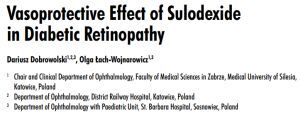Current issue
Archive
Online first
About the Journal
Editorial Board
Scientific Board
Reviewers
Abstracting and indexing
Publisher
Contact
Subscription
Ethical standards and procedures
Abstracting and indexing
For authors
Ethical standards and procedures
Publication charge
Books and Events
Books
Events
REVIEW PAPER
Vasoprotective Effect of Sulodexide in Diabetic Retinopathy
1
Chair and Clinical Department of Ophthalmology, Faculty of Medical Sciences in Zabrze, Medical University of Silesia, Katowice, Poland
2
Department of Ophthalmology, District Railway Hospital, Katowice, Poland
3
Department of Ophthalmology with Paediatric Unit, St. Barbara Hospital, Sosnowiec, Poland
Submission date: 2023-12-27
Acceptance date: 2023-12-28
Publication date: 2023-12-29
Ophthalmology 2023;(4):19-22
KEYWORDS
ABSTRACT
Diabetes is a group of metabolic diseases, considered a lifestyle disease. Diabetic retinopathy is the leading cause of blindness in working-age adults worldwide. Pathogenetically, due to the changed anionic charge, collagen gradually replaces glycosaminoglycans (GAG) in the basement membrane of retinal capillaries, affecting vascular permeability. Clinically, these changes cause leakage from the retinal capillaries, which leads to the development of microaneurysms and, consequently, the formation of hard effusions (HE). Sulodexide is a glycosaminoglycan containing 80% of small molecular weight, fast moving heparin fraction (FMH) and 20% of dermatan sulfate. An important target of sulodexide's action are vascular endothelial cells, and its protective effect is partially related to the preservation and reconstruction of the glycocalyx structure on the surface of the endothelial layer cells. Additionally, sulodexide has been documented to strengthen the glycocalyx of retinal arterioles in people with diabetes. These findings suggest that sulodexide holds promise as a potential therapeutic agent for the treatment of diabetic retinopathy.
Share
RELATED ARTICLE
We process personal data collected when visiting the website. The function of obtaining information about users and their behavior is carried out by voluntarily entered information in forms and saving cookies in end devices. Data, including cookies, are used to provide services, improve the user experience and to analyze the traffic in accordance with the Privacy policy. Data are also collected and processed by Google Analytics tool (more).
You can change cookies settings in your browser. Restricted use of cookies in the browser configuration may affect some functionalities of the website.
You can change cookies settings in your browser. Restricted use of cookies in the browser configuration may affect some functionalities of the website.




